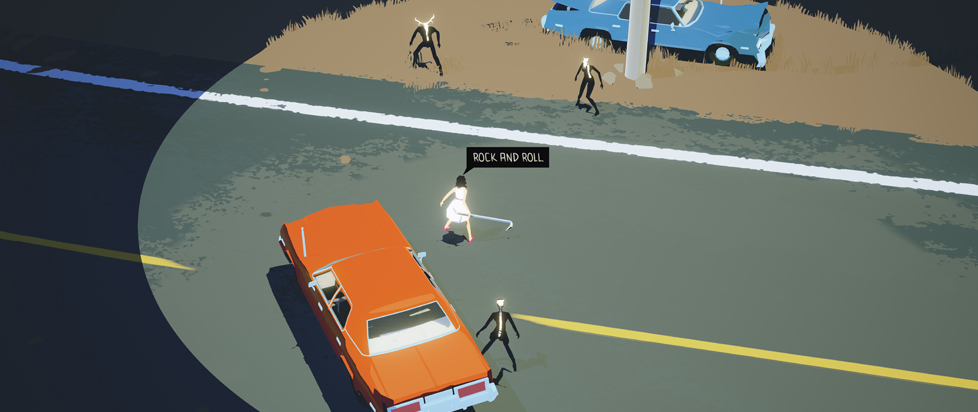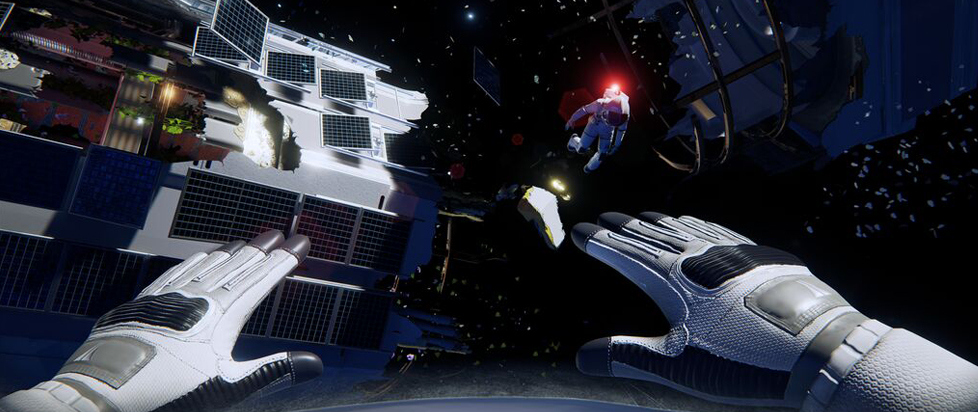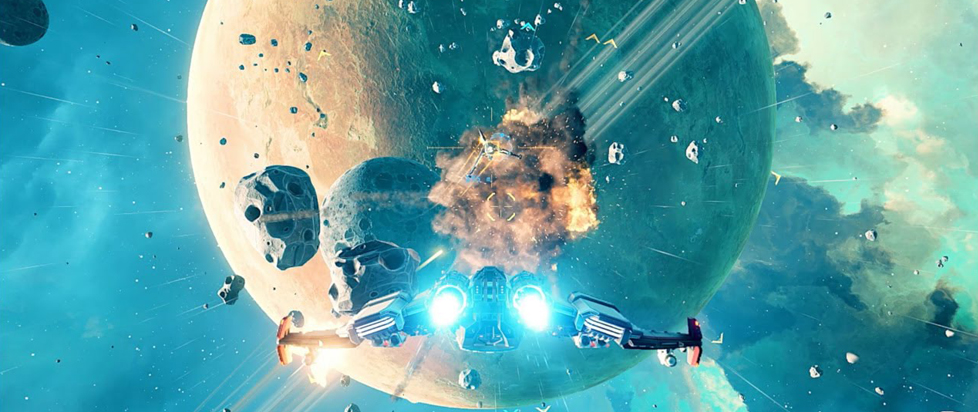
Revving the Engine – Everspace
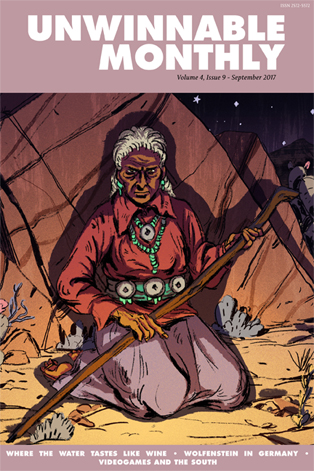 This column is a reprint from Unwinnable Monthly #95. If you like what you see, grab the magazine for less than ten dollars, or subscribe and get all future magazines for half price.
This column is a reprint from Unwinnable Monthly #95. If you like what you see, grab the magazine for less than ten dollars, or subscribe and get all future magazines for half price.
———
This series of articles is made possible through the generous sponsorship of Epic’s Unreal Engine. While Epic puts us in touch with our subjects, they have no input or approval in the final story.
———
If you are wondering what Everspace is, one enthusiastic fan put it best, saying, “Everspace is like Freelancer and FTL made sweet love and had a baby!” Even without the exclamation points of fandom, Everspace is an impressive new breed of space game – a narrative focused roguelike that is easy to pick up and play, yet challenging to the very end.
The core of Rockfish Games are best friends Michael Schade and Christian Lohr. The pair have been making beautiful digital imagery since their student days in the late 80s, eventually becoming the talent behind one of the leading German CGI studios in the 90s, creating on architectural visualizations using game engines. From there, they moved into development of mobile games as Fishlabs Entertainment, developing highly rated titles like Rally Master Pro and Snowboard Hero. Their biggest hit was Galaxy on Fire 2, a space fighting sim. Despite predicting the gaming potential of mobile, they failed to see the market’s shift to free-to-play and Fishlabs folded. Undettered, Lohr and Schade have embarked into independent development for PC and console games. Everspace is their big comeback.
Everspace is currently available on Steam, Xbox One and PS4. The team at Rockfish Games is currently working on a large add-on featuring a new player ship, weapons, questlines and characters adding about ten hours of gameplay. Though set for release in October, Michael Schade was kind enough to take time and answer our questions about the game. It’s a deep dive, so I’ll cut the preamble short and get right to it.
Why develop space sims? What’s your attraction?
Well, we have been creating 3D space shooters since 2004 and some 30 million gamers have played the Galaxy on Fire games. Galaxy on Fire 2 and its HD version became wildly popular, so we thought we might be able to reactivate our fanbase and bring them over to PC and console. Plus, everyone of the core team has always been a big fan of Wing Commander and Freelancer, so we felt there is more than enough space for yet another space game, even next to genre juggernauts like EVE Online, Elite: Dangerous, No Man’s Sky and Star Citizen.

Space sims seem to be having a bit of a resurgence, especially in the indie sphere. Can you ruminate on why space sims fell from favor, and why they’re coming back now?
I think it all started back in 1990 with Wing Commander from Chris Roberts, which brought a good-looking three-dimensional game experience to the PC for the very first time. When GPUs were coming to the PC during the sixth generation of consoles in the mid-90s, we saw the release of lots of great 3D space games like Star Fox 64, Colony Wars, Descent and Rogue Squadron, just to name a few.
The reason for this is obvious. The rendering performance was still the bottleneck, but it only takes a few polygons to move around in 3D space in front of a beautiful backdrop to make a good-looking game. And, unlike in a first or third person shooters, there is no character animation to worry about. Actually, this is pretty much why we started making Galaxy on Fire for Sony Ericsson and Nokia phones back in 2004, when we had to deal with a 100 MHz CPU, no GPU whatsoever, a screen resolution of 128 x 128 pixels and a maximum file size of 350 KB for the whole game.
With the rapid improvement of rendering power on PCs and the seventh console generation, in combination with sophisticated game engines and 3D design tools, first person shooters quickly stole the thunder from space shooters. We believe it is because of the immersive experience you get when playing in first person view combined with less complex controls and better orientation thanks to mostly moving on a plane instead of dogfighting in a 3D-space environment with six degrees of freedom and enemies approaching from all angles.
The last major space game hit of that era probably was Freelancer. There were other great space games afterwards but with less commercial success. Publishers turned away from the genre. Ironically, in spite of the commercial success of Elite: Dangerous, No Man’s Sky and even Star Citizen, the latter making over $150M in revenue even before being released, the reluctance towards space games had not changed one bit when we pitched Everspace to publishers with a rock solid pre-Alpha about two years ago.
There certainly still is a large audience for space games out there. And since the big publishers haven’t served that niche for quite a while, it was just a matter of time until indies took the risk of filling that void. Lastly, since we’ve been getting lots of praise for Galaxy on Fire from more than 30 million players on mobile phones for over a decade now, we were sure that we’d always been onto something. Obviously, Chris Roberts, David Braben and Jean Murray thought so, too.

Can you speak a bit about your decision to marry the space sim to the roguelike? It seems an unusual choice at first, but once you get into the game, it’s a perfect accompaniment. What about the mechanics of roguelikes appeals to you?
Our core team has been playing a lot of roguelikes and has become quite fond of the genre over the years. A roguelike 3D space shooter had not been done before, so we figured that roguelike elements were something that would set us apart from all the other space games out there. Also, since many roguelikes are indie productions with 2D retro graphics we felt that we could offer something new and draw a wider audience, including players who’ve never even played a roguelike before, by making the game as visually appealing possible.
What we love most about roguelike mechanics is the high replay value you get with randomization and procedural generation and that you can’t get better at these games by learning certain encounters by heart and trying the exact same thing over and over again. As you’re always going to be thrown into different situations you only get better by gradually learning more and more about the game mechanics and developing a better understanding of which works best under which circumstances. Roguelikes demand a lot of fast decision making and improvisation – they keep you at the edge of your seat at all times and can be quite hard, but it’s a great feeling when you manage to get out of yet another sticky situation.
How do approach narrative in Everspace considering the roguelike elements?
Everspace takes place in the distant future, so we made use of the cloning theme, which is a perfect fit for a game in which you die a lot. While this constant resurrection is explained with being a clone pilot, the randomly generated areas are a result of the newly plotted course through space at the start of each run. There was no need to explain the roguelike elements in Everspace, but since they were a good match for the story we wanted to tell, we took advantage of that and brought both together.
While the player is in a constant loop of dying and reviving, the characters he meets are not. We carefully placed encounters along the player’s journey that, in combination with the flashback cinematics, slowly reveal both the player character’s past as well as the nature of his mission.
One could say that we embraced the logical implications that come with certain roguelikes and tried to explain them within the narrative structure. The sci-fi them just seemed like a perfect fit.
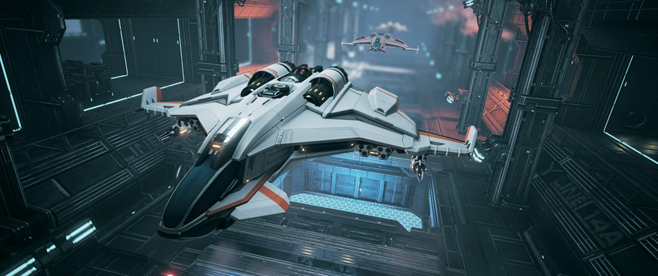
The game looks gorgeous. How’d you go about making space visually sumptuous?
We had been creating 3D space shooters for low-spec feature phones all the way up to powerful smartphones for more than ten years, so we knew how to make space look cool. However, we knew there was no point in trying to compete with the photorealism in Elite: Dangerous or Star Citizen with their AAA budgets and huge teams of hundreds of developers. More importantly, we wanted to have an art style that fits the character of an arcade space shooter, featuring vibrant colors and stunning visual FX for firing weapons, big explosions, natural hazards and whatnot. It had to make you want to dive right into the action. For this, Guardians of the Galaxy was one of the greatest influences.
So we went for a more romanticized interpretation of a fantasy space setting with a unique color palette for each of the sectors. These define the colors of up to three suns per solar system and the pre-dominating tint of the sector. Typical for roguelikes, the jump targets of each sector are procedurally-generated levels, filled with various types of backdrops, planets, nebulas, asteroids, space stations, shipwrecks and other points of interest.
These assets are combined following fairly strict rules to create a specific look and feel with enough freedom to make every location look unique. Now, to achieve that AAA-ish look, all 3D props were designed in a classic art pipeline, starting out quite rough with concept art thumbnails, followed by 3D block-out models with several variants and complexity for playtesting, concept art overpaintings to define details of hero assets, 3D high-poly meshes to create textures and maps for various shaders, and finally in-game low-poly models with five LODs, each.
A lot of effort also went into creating top-notch visuals FX by taking full advantage of modern GPUs. This is where the Blueprints in Unreal Engine shine. Marco Unger, our Lead and Technical 3D Artist, had great fun going crazy combining all sorts of shaders to render GPU particles like there is no tomorrow. Don’t ask me how exactly he does it. Every time you walk past his workplace, you’ll see amazing stuff on his monitor. The design process of making top-notch VFX in UE4 is so fast there is almost no need for pre-production.

Was the process similar for the sound design?
Often in game development, creating and implementing great sound is neglected. We believe a captivating sound experience is almost as important as having stunning visuals in the game. Especially in a space shooter without a lot of things around you, firing an energy weapon or ballistic gun does not only have to look good, it also has to sound satisfying. How disappointing would it be, watching baddies blow up in a huge explosion without a massive KABOOOM!? Of course, we still get smart comments that there are no explosions or sound in space. Don’t tell George Lucas, I guess.
The sound design in Everspace goes way beyond those basics. Gero Goerlich, our Sound Director, has been working with us for ten years, mostly on space shooters, and he has spent countless hours of research for cool real-world sounds, to tweak and mix them with electronics samples in our in-house sound studio until every single weapon, device, ship engine, shield charge, damage impact, warning message and every little blip got its right sound. In total, there are over 900 unique sounds and more than 60 originally composed music tracks in Everspace, most of which are blended in real-time, depending on what’s going on in the game.
Your past work was primarily on mobile. Why make the move to indie? How did the transition go? Learn any valuable lessons?
We didn’t plan on going indie. When our previous mobile games studio was in financial trouble, we fought to adapt to the massive changes in mobile gaming. Ironically, we had to get forced out of the studio before we sat down and asked ourselves what we are good at, what we would really like to do and what our opportunities are.
The transition from mobile to PC went smoothly. We worked on the PC and Mac versions of Galaxy on Fire 2 before, so we already had a glimpse of what to expect. When the time came, the switch from a proprietary engine running on restrictive devices to a high-end cross-platform engine on the most powerful platform was exciting for us. Our mobile legacy helped us contain ourselves and take small steps. After all, we suddenly had much more power and with more power comes more responsibility – gamers on PC and consoles expect another kind of quality level compared to mobile gamers, who are more inclined to forgive graphical glitches, crashes and choppy performance. However, in the end it all boils down to transforming a good idea into a fun and contemporary game, regardless of the platform you are developing for.
Are there any unexpected benefits or challenges to using Unreal Engine 4?
When we entered mobile gaming in 2004, there was no tech available to develop 3D mobile games. We had to create our own proprietary 3D mobile games engine. It was super lean on features but heavily optimized on performance. With the rapid performance gain of smartphones, it was an uphill battle for our small engine team to keep up with the feature set and functionality of Unreal. Our artists pushed towards making the move. Eventually, we had to use Unreal Engine 4 because the AAA publisher we signed with had licensed it and we had lost the rights to our previous tech. In hindsight, this was one of the best things that has ever happened to us.
Working with Unreal is a totally different experience. We have everything in one place: meshes, textures, materials, UI elements, code, blueprints and so on. Pressing play lets us immediately test things, which allows for very fast iteration cycles. Cooking times for release builds are high and as some bugs only occur there, so we often have to wait half a day to see if a problem has been fixed by a change.
Engine updates are also a double-edged sword. They bring a ton of cool features and bug fixes, but also introduce new bugs and sometimes dictate new ways of doing things that require refactoring on our end. We wait often delay before migrating the project to a new major engine version.
We were surprised by the amount of features that artists can carry out themselves. Our technical artist took great pleasure in constructing smaller blueprints and became so good at it that he is now able to create complex blueprints without any help. Even artists who don’t want to delve into the blueprint system at least understand the greater context, how assets are related to each other and can thus find and fix smaller issues. This is a great benefit compared to multiple proprietary tools that demand specialized operators.


